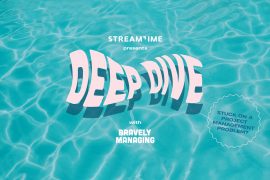Whether you’re freelancing or running an agency, figuring out what to charge for your services is one of the trickiest tasks in the creative industry. From hourly pricing to value pricing, there are all kinds of hotly debated pricing strategies to wrap your head around.
But which one is right for you? We talked to a range of people from different disciplines to find out how they approach pricing to run a healthy, profitable business.
What makes a good pricing strategy?
From market demand and taxes to the strength of your competition, there are many factors that can impact revenue. But one of the most important will always be your pricing strategy.
Having a good pricing strategy involves figuring out the price point at which you can maximise profits. So you’ll have to consider distribution costs, positioning strategies and your customer base when setting your pricing strategy.
It’s also all about finding the right balance. On the one hand, you don’t want to scare away customers with unreasonably high prices. On the other, setting your prices too low can put your business at risk as you might not be able to cover all your running costs or make a profit.
Different pricing strategies work for different businesses, so for the rest of this article we’ll look at some of the most common strategies, and which ones could work for you.
But first – a word on low pricing
We talked to Leon Brown, an education content developer from Liverpool, about his thoughts on low pricing.
“A lot of people fall for the mistake of thinking that offering the lowest price is the only way to win work,” he warns. “All markets have buyers with different characteristics, which a pricing strategy must reflect. Going for the lowest price is an option, which will be attractive to customers who put price above quality and who don’t need or can’t afford the highest quality.”
So here we see that pricing needs to align with your product and brand, and how valuable you want your business to be perceived. But Brown also stresses that it’s important to be realistic about pricing. “It’s very easy to guess a price, then later find out that the quote will lose you money,” he explains.
“If you have costs to pay out to deliver the work, then you at least need to make sure that what you are getting paid is more than you are paying out. Similarly, you don’t want to be giving your time away for free. You need to make sure you identify the break even point as a mixture of costs and time expenses; or time and materials.”
If you opt for the lower pricing model, one way to remain profitable is to identify what can be cut out to reduce costs. “This is how Alan Sugar was successful with Amstrad,” Brown argues. “He sold hi-fi systems and other technology goods that cut out expensive components to keep their costs down. They were good enough for the average person who would otherwise not have been able to afford or make an impulse purchase for the prices being charged by his competitors.”
How to know if you have the right pricing strategy?
Many agencies still price their services based on a time and expenses model, retainer model, or fixed-price model. Of course, if they work, there’s nothing wrong with using these strategies. But are they always the best approach?
Not necessarily. And it’s worth pointing out there’s also an emerging shift towards value pricing models. For freelancers and agencies, this can be a great way of building long-standing (and mutually beneficial) relationships with clients.
When it comes down to it, there’s no single ‘right way’ to price your services. It really depends on how much preparation and research you’re willing to undertake (e.g. to understand your customers, company and competition), and how often you’re testing, reviewing and evolving your strategy. Critically, you also need to make sure the pricing model is delivering on your profitability goals.
Choosing the best pricing model for your creative agency
To get a better idea of the debates surrounding pricing strategies, we talked to a number of freelancers and industry leaders to get their thoughts on hourly, value-based, fixed-fee and project-based pricing.
Hourly pricing
Since she started out as a freelancer, content strategist Saskia Videler has always tracked the time of all her processes. “I decide on a project price by estimating the total of hours all the tasks will take, based on earlier projects,” she explains.
“Of course, you’ll have to also try and evaluate what kind of client you’re dealing with: high or low effort? Will they be on time and accurate in their feedback? Try to account for that margin.”
Shirley Wu, a freelance software engineer who builds data visualizations, argues, “When I charge by the hour, I feel like I have to be 100% efficient – there can be no wasteful actions.” However, she explains that this “really impedes creativity, because a lot of times when I’m exploring or prototyping, I’m just trying out ideas that may or may not work out.”
Meanwhile, freelance illustrator and designer Paddy Donnelly advises to constantly re-evaluate your price. “After you complete each new project, you’ll have learned new skills, had new design experiences and grown as a designer, so why shouldn’t your daily rate reflect that?
Donnelly goes on to say, “Recently, I’ve been moving towards a more value-based pricing model for projects. As I develop more as a designer, the specific number of hours it takes me to create a finished design becomes less important. My clients are paying for the result, so should it really matter if it takes me one hour or eight hours?”
Consultant front-end architect Harry Roberts echoes this approach. He says, “Avoid – as much as you can – pricing based on any unit of time. It seldom works out in anyone’s favour (yours or the client’s). Something you can deliver in an hour may be worth everything to someone else.”
While hourly billing can be a profitable approach, it’s no surprise that a lot of designers and developers warn against hourly billing.

Looking for reasons to switch to value-based pricing? We recommend checking out software consultant Jonathan Stark’s book, Hourly Billing Is Nuts, as well as his accompanying podcast Ditching Hourly.
Value pricing
Value pricing can be scary at first. But it can also be a fantastic way to align your goals and your client’s goals, create genuine and lasting relationships, and get motivated by the risks and rewards of the end result.
Ben Parizek, partner and creative director at Barrel Strength Design, says it best: “Pricing should not reflect how hard you work, it should reflect the value you are able to create. If you can’t create value, you don’t want to have a price that tempts clients to think that you can create value for them – those relationships always end badly.”
To figure out how much her work was worth, Saskia Videler started reading How to Measure Everything by Douglas W Hubbard. “It teaches you to work with all the data you have or are able to gather. That way you would be able to calculate the financial impact your work would have and thus the worth of your work for your client. I just haven’t had the guts to really experiment with this.”
This seems to be the biggest hurdle with adopting a value pricing model – actually taking the leap. In fact, it took designer Lauren Elizabeth a long time to get out of the ‘time = money’ mindset.
“It made a lot of sense,” Elizabeth enthuses. “If the client is making $100k from your work, billing $25k is a no-brainer.” However, her main challenge was measuring her value. To overcome this, she asks herself two questions:
- How much do I think this project is worth to the client?
- How much is this project worth to me?
She explains that, by answering these two questions, you’ll be able to communicate to the client that you’re an investment, not an expense. And this will really help to emphasise the value of your business too.
Elizabeth adds, “I don’t overthink it. I’ll come up with a cost that gives me sufficient leeway to be attentive and ‘go the extra mile’ for my clients. I’ll pop it into my proposal, quickly add 10% just in case, and hit send.
According to Thomas Cornwall, head of service design at digital business transformation company Rainmaker, this kind of confidence matters – but that the key to charging what you’re really worth is about solving a valuable problem in the right way for the right client. To help define your most valuable work, Cornwall suggests breaking it down like this:
- Activity I’m good at
- Fulfilment index (0-10)
- Value to the market (0-10)
- Profitability index (0-10)
He elaborates, “Let’s say I’m good at cleaning. I enjoy it, so it’s about 8 on the fulfilment index. The value to the market is low, say 2. And it’s not very profitable because I have to do the cleaning. So I’m never going to be able to charge what I’m really worth if I do that.”
“Now let’s say I’m good at sales copywriting,” he continues. “Again, it’s about an 8 in terms of fulfilment. The value to the market is quite high, say 6. And it can be very profitable, say a 7, if I charge a commission for my services. So I might choose to pursue that and think about other ways I can improve to create more value, such as 24/7 email access or faster delivery.”
“Charging what you’re worth means being a master of your craft and a master of communication. It’s not easy, there are no ‘secret overnight hacks’, but you can double or increase what you’re charging now by five or ten times, if you follow the right process. After all, perception is reality. And reality is negotiable.”
Presenting value pricing to a client
This is a challenge of value pricing. That’s why Jen Hood, creative director and co-founder of Californian branding and design agency Hoodzpah, always aims to give the client a reference to base the value on.
“Many times our clients have not dealt with a designer before and have no reference for quality industry pricing,” she describes. “So when I send the price, I’ll show them how the cost will be paid off in terms of their own product.
To dig deeper into this, she says, “For example, a hotel bought a set of spot illustrations for use only on tote bags at one localized event. When they returned to license the work perpetually, the price was going to be significantly higher, as they have 18 properties with a very large potential audience and therefore the value is much higher.”
“So I framed the price in these terms to them: if you post only one of these designs on one of your property Instagram accounts, which has around 20k followers, and 50 people rent a room because of it (that’s a mere 0.25% of the audience), then you will have recouped your cost. That turns a very large number into a very large value.”
Hood explains that you need to speak in the client’s ‘value’ language to create mutual understanding. To do this you have to understand their product, and do a little research on how their company makes money and perceives value. Ask them what their main company goals are – growth, profit, reaching new demographics – and frame the price value accordingly.

Sam Dungey, general manager at Ocean Design, says that value billing was absolutely the right way for the New Zealand agency. While he admits that there are some pitfalls of value pricing, he also says, “it’s nothing that clear communication and good management tools like Streamtime do not solve.”
Fixed-fee vs. project-based
Fixed-fee pricing is when you estimate the costs of a project by calculating the number of hours required by the project. You also have to consider the hourly rate per employee or agency, and then add on a buffer fee or margin.
This kind of pricing model often includes retainer-based work and is best suited to clients who have a budget to adhere to, and know exactly how much a project will cost and when they need to submit payment.
The major pitfall of fixed-fee pricing? Projects will often change and evolve, which means your estimate can quickly become incorrect and costly, reducing the profitability of the business. This is why some freelancers and agencies prefer the project-based pricing model.
Of course, project-based pricing requires you to be confident at scoping and project management, which can be limiting in its own way. For example, you might become hesitant to suggest new and better ideas that would improve the final product for the client.
While different strategies work for different agencies and clients, it can be worth thinking the way Seamus Holman does, founder and creative director of Gridwork, who uses a mix of models.
“The mix is different for each client,” he explains. “I am very intentional about not including any fixed number of hours on retainers anymore. In the past that required tracking, reporting, prorating, or needing to bill extra. Instead, we offer things like unlimited questions via email, one full day per month, unlimited bug fixes, font licensing, CMS updates, performance monitoring, and SEO tracking.”
It’s a similar case for UX designer and strategist Christopher Cashdollar, who has become more flexible and creative with his pricing model over the years.
“No single pricing model fits me because I take on very different types of engagements and I like to diversify my cashflow,” he says. “This means I like to make sure I have a mix of ways money comes in. Fixed price projects as well as hourly gigs are both happening at the same time in my studio, sometimes even for the same client.”
Over to you
There’s no denying that pricing is a complicated arena. Often, the arguments for hourly or fixed-fee pricing are just as valid as the arguments for value pricing. But each has its own merits – and can be used independently or in combination.
The most important factor to remember is that pricing isn’t a one-size-fits-all type deal. Figuring out the right pricing strategy that fits your business model and value takes time, effort and many productive conversations with your clients and your team.
The good thing is, once you find a pricing strategy (or strategies) that works for you, you’ll not only discover that your finances will improve, but that you’ll actually enjoy the work you do that much more.








5 Comments
Very good post! We will be linking to this particularly
great post on our website. Keep up the great writing.
Good post!
Great post! We are linking to this great post on our site.
Keep up the great writing.
It’s like you read my mind! You seem to know so much about this,
like you wrote the book in it or something.
I think that you could do with some pics to drive
the message home a little bit, but other than that,
this is excellent blog. A great read. I will certainly be
back.
It’s awesome to visit this web page and reading the views
of all colleagues concerning this article, while I am also zealous of getting know-how.